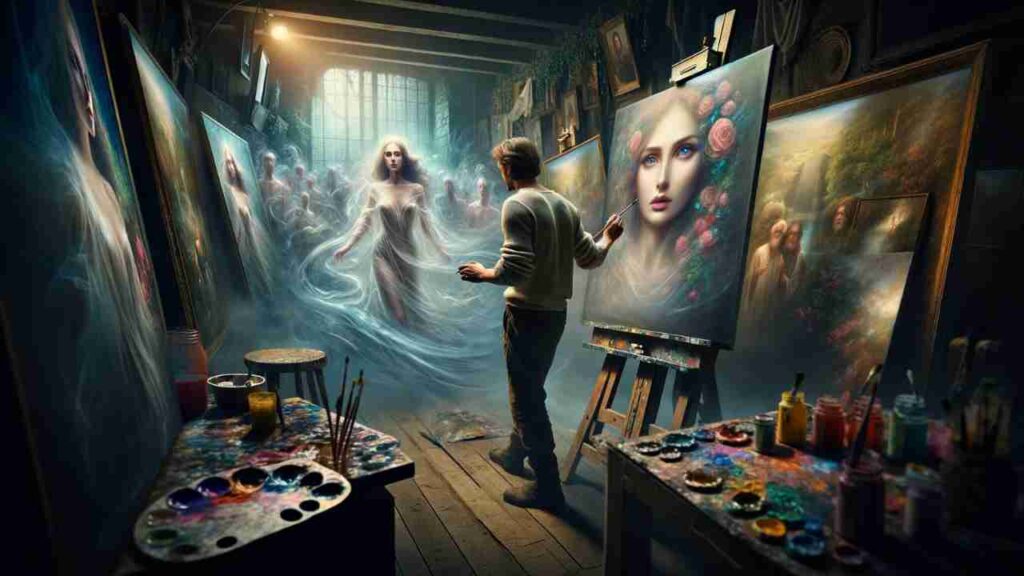Once upon a time, there was a very good painter. He made wonderful pictures. But he had a funny problem. When he painted something, he thought it was real! If he drew a pretty lady, he wanted her to be his friend. If he painted a scary monster, he was afraid it would jump out of the picture to get him! People wondered, “How can he think his drawings are real?”

Guess what? Sometimes, we are a bit like that painter. If we are mad at someone, it’s not really them we’re mad at. It’s the picture of them we keep in our heads. Like if someone was mean to you once, you remember it and feel upset, even though it happened a long time ago. That mean moment is gone, but we keep thinking about it.
We’re all a bit silly like that. It’s easy to know that everything keeps changing, like how a river keeps flowing. Our memories are like looking at pictures in a car’s rearview mirror. But sometimes, we forget to look forward and keep staring at those old pictures. That’s when we can make mistakes.
It doesn’t matter how we got to where we are now. What matters is that we’re here. Today is the most important day. Right here is the best place to be. Right now is the only time we have. The only real thing is what’s happening right now
Another Version for Taking English Language to The Next Level
In a quaint corner of the world, there lived a painter of extraordinary talent. His brushstrokes brought to life breathtaking vistas, enchanting figures, and scenes so vivid they seemed to leap off the canvas. Yet, this gifted artist harbored a peculiar affliction that both fascinated and bewildered those around him. To him, the boundary between the painted and the real was indistinct, a thin veil that his mind effortlessly traversed.

Imagine drawing a figure so exquisite that its beauty transcends the confines of the canvas, compelling a deep yearning to share a life with this creation. Or envisioning a creature so formidable that its mere representation instills a palpable dread of impending doom. This was the painter’s reality—a world where the line between imagination and existence blurred into obscurity.
Observers marveled at his genius but questioned his grip on reality. “How can one not distinguish between the world of art and the tangible world we inhabit?” they pondered. Yet, in their haste to judge, they overlooked a profound truth that this painter inadvertently mirrored—a truth about human nature itself.
We, too, are artists in our own right, painting incessant portraits within the recesses of our minds. Our canvases are populated not with oil or acrylic, but with the impressions and memories of those we encounter. When animosity takes root, it is not the person we despise but the image we have crafted of them, an image colored by past interactions, biases, and emotions.
Consider the individual who once wronged us. The act, confined to a singular moment in the past, is immutable, yet the person continues to evolve, independent of our frozen tableau. The disdain we harbor clings not to the person as they are but to a shadow, a relic of bygone times. Our minds, ensnared by these vestiges, relive the anguish, oblivious to the passage of time and the transformation of individuals.
This tendency to dwell in the corridors of our memories, to wage wars against phantoms of the past, is a testament to our shared folly. We possess a fleeting clarity, recognizing life’s ephemerality and the fluidity of our experiences, akin to a river’s unending flow. Yet, this wisdom often proves ephemeral, dissolving as we resume the mundanity of our routines. Engrossed in the rearview mirror of our lives, we risk neglecting the path unfolding before us, inviting calamity.
The essence of our journey lies not in the trails traversed but in the moment of arrival. The present is our sole reality, a singular point in the vast tapestry of existence where past and future converge. It is in the “now” that we truly dwell, amidst the ever-shifting sands of time and perception.
Let us embrace the lesson of the painter—not as a cautionary tale of delusion, but as a beacon guiding us towards mindfulness and presence. In acknowledging the transitory nature of our memories and perceptions, we can liberate ourselves from the chains of the past, turning our gaze forward, to the boundless possibilities that await in the here and now

